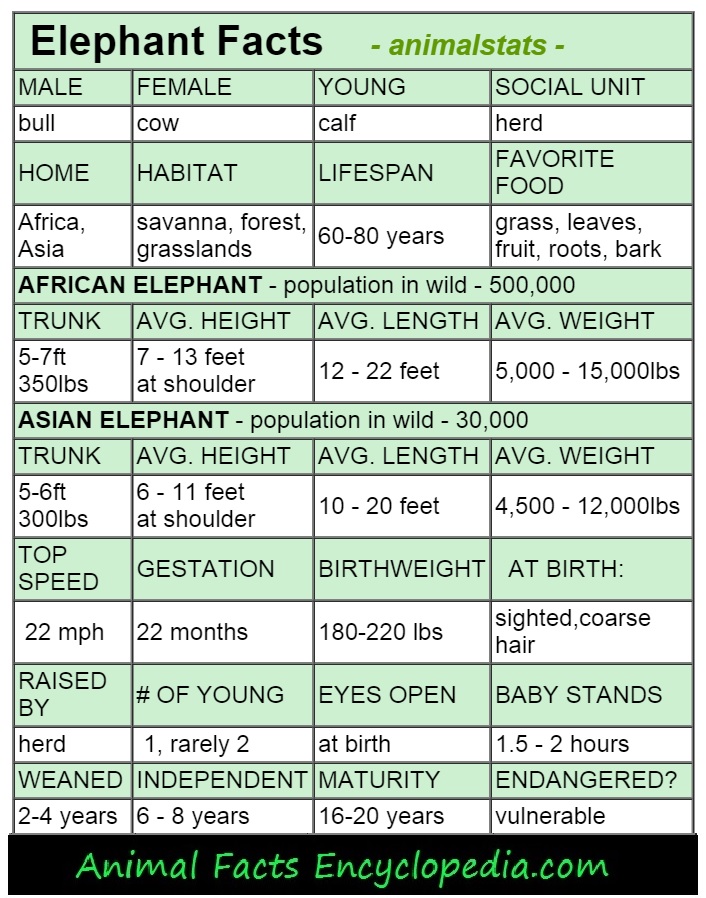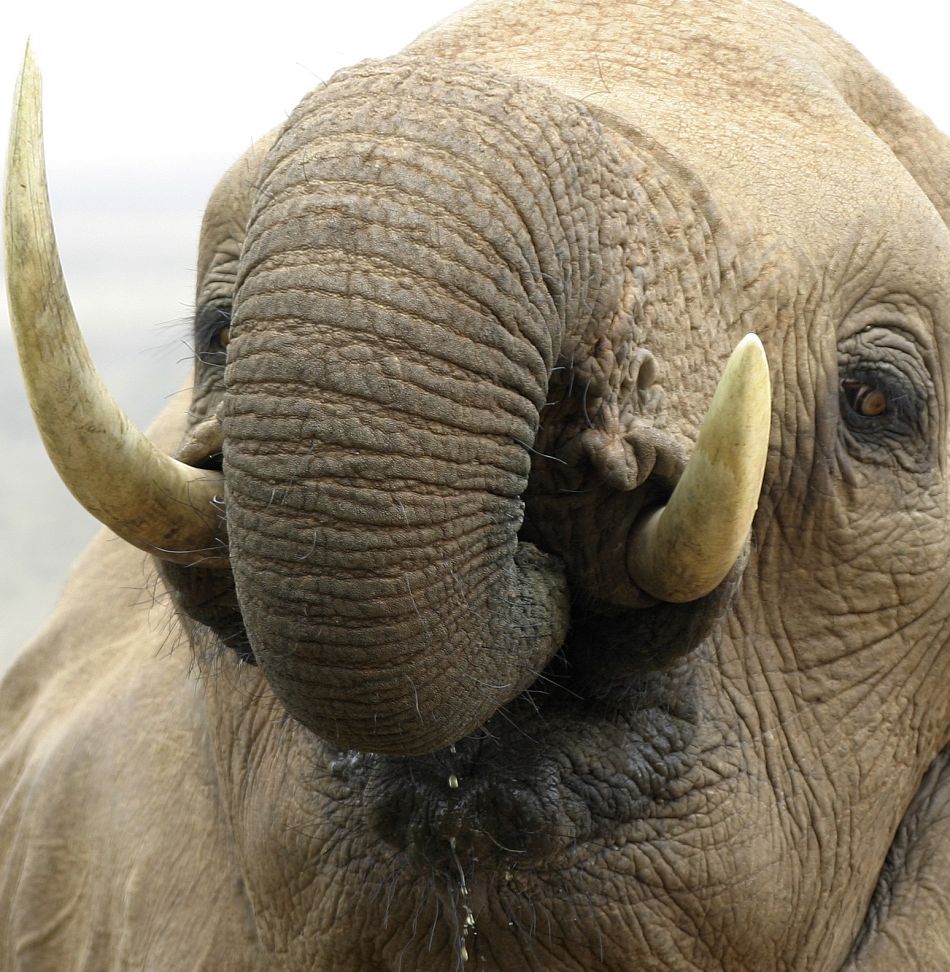elephant Facts
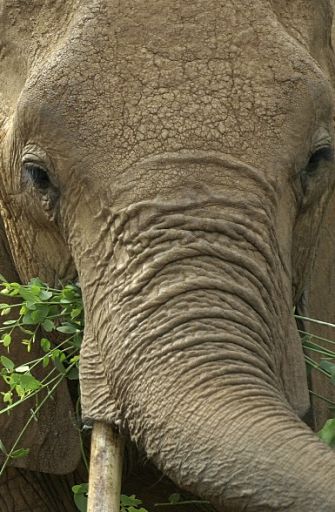 Portrait of an African Elephant
Portrait of an African ElephantAveraging 10 feet tall and 12,000 pounds the elephant is the largest animal on land. There are 2 species and 6 sub-species spread across the warm forests and savannas of Asia and Africa.
The Sumatran elephant, the smallest sub-species, may only stand 6 feet at the shoulder when mature, but the massive bush elephant of Africa has been known to reach 13 feet tall.
Elephants live in herds of 6 to 30 individuals that may join up occasionally with any of several other herds within the master social structure known as a clan. There may be up to 400 elephants within the clan, and it is believed that elephants may recognize and have different relationships with all of their fellow members.
Females stay with the same herd usually for their entire lives, only occasionally branching off to form a new herd. Young males live with the herd until 8 to 10 years of age after which they may wander about in small groups of males for several years, but eventually live solitary lives, only joining up with herds for a few days a year to mate with available females.
Although elephants have been used as beasts of burden in Asia for thousands of years, the Asian elephant is not a domestic animal. Elephants are captured from the wild when they are young adults and trained through ancient techniques by elephant handlers called "mahouts".
The means with which they control and train wild-caught elephants is unpleasant at best, and includes the use of large steel hooks called ankusas, long poles, ropes and chains.
Elephants have also been used in circus shows as far back as Ancient Rome where they were often pitted against lions and bears in battles that were considered to be great entertainment.
The intelligence and emotional depth of both the Asian and African elephant is legendary, and fortunately, the tide is turning against the casual use of these highly advanced creatures simply for our amusement.
The African elephant has a vulnerable status as a species, and the Asian elephant is listed as endangered.
These animals are difficult to breed in captivity and the maintenance of a wild population on both continents is critical to the elephants long term survival on our planet. - Elephant Facts.
The amazing elephant
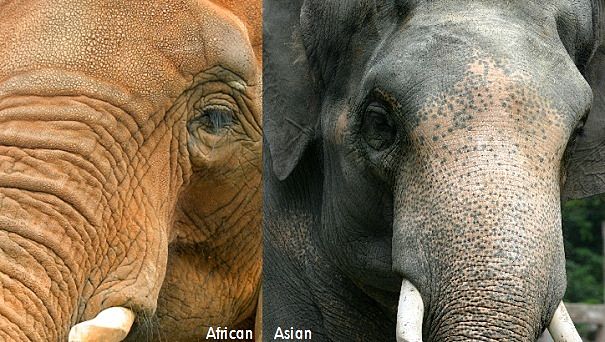
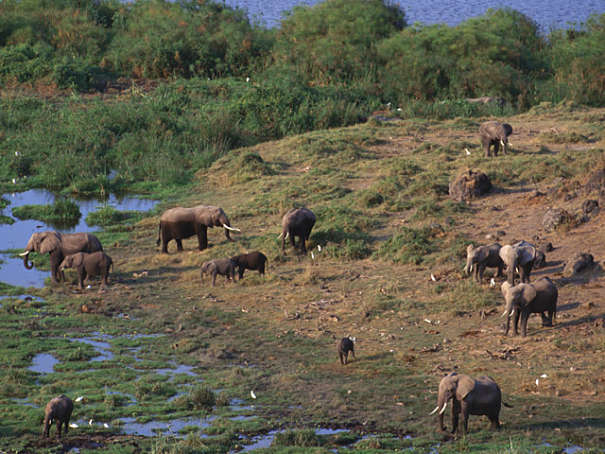
The elephant has the longest childhood of any creature on Earth, including us! Males may not reach sexual maturity until they are thirty years old, and may not have an opportunity to mate until they reach the prime age of 40 to 50 .
Females may nurse a calf for 6 years, and may only have 3 kids in their lifetime.
Although ape species have been known to mourn over the remains of the lost, only elephants and humans routinely show reverence, and even ritual, years after the passing.
Herds will pause at the location of an individuals death for years after the occurrence. While bones are still present, they will fondle and carry them about. Once nothing remains, individuals may still linger and remember.
The elephants memory has become famous mainly because of the many stories where elephants separated for decades from each other, from human friends, or even in one case from a pet parrot, showed obvious delight in the form of head-rocking, vocalizing and tender touching with eager trunks upon their reunion.
In one such case, some detective work revealed that the two joyfully reunited elephants in question hadn't seen each other in fifty years.
It was only recently discovered that African elephants regularly make sounds that are too low for humans to hear..... yet loud enough for elephants miles away to respond to! - Amazing Elephant Facts
elephant reproduction
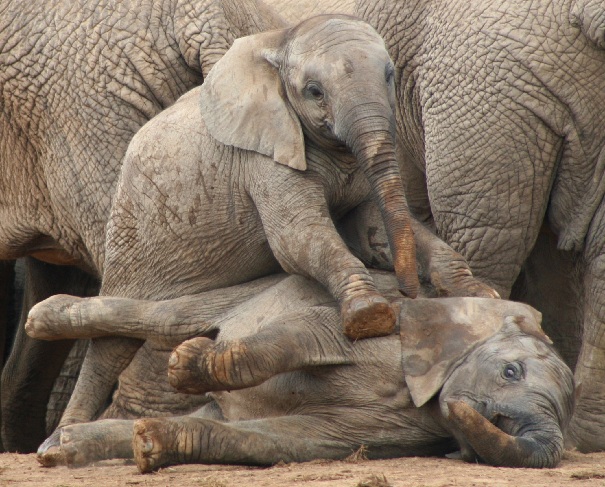 Elephant babies
Elephant babies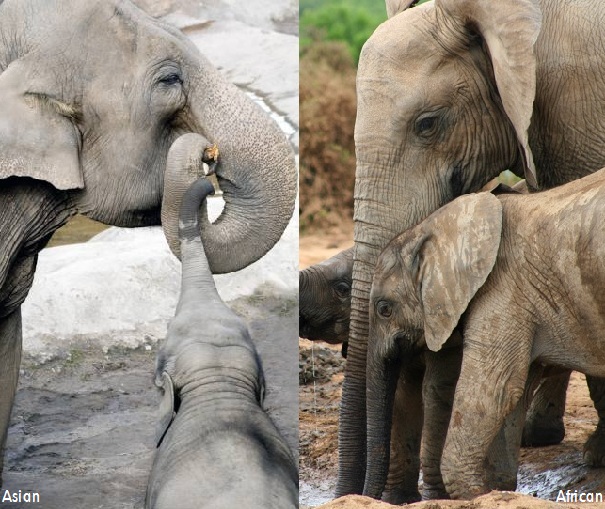 Baby Asian and African elephants with moms
Baby Asian and African elephants with momsWhen male elephants reach 25 to 30 years of age they begin to experience a yearly spike in testosterone known as musth -a Hindi word which means "intoxicated". Musth may occur at any time of year and will last from 15 to 90 days.
The male will become restless, agitated and sometimes violent as the rise in hormones sends him searching, often without sleeping or eating, for a female in estrus.
Females come into estrus 3 times a year for only 4 days at a time. They project a scent that attracts males in musth and when more than one male arrives a violent fight may ensue involving charging and wrestling, one set of huge tusks and muscular trunks against another.
Males rarely gore or otherwise seriously injure each other, but the battles may be long and exhausting, and sometimes the victor turns around to find his love interest has simply wandered away.
Musth is an uncomfortable time for males as they single-mindedly pursue a mate. Unique to elephants, two temporal glands located behind the eyes secrete a trail of fluid down both sides of the face, and a steady dribble of noxious urine marks every step the male takes.
Once impregnated, the mother carries her calf for almost 2 years, then, with the herd forming a circle around her to protect her, she gives birth while standing up, to a 200 pound calf.
The calf, who may be remarkably hairy at birth, will not be able to stand for the first hour or so which is a very nervous time for the herd. Eventually the calf will struggle up to nurse and can walk 2 hours after birth. Females have 2 teats right behind their front legs and baby elephants have been known to nurse (by mouth not by trunk) for up to 6 years! - Elephant Facts

the elephants trunk

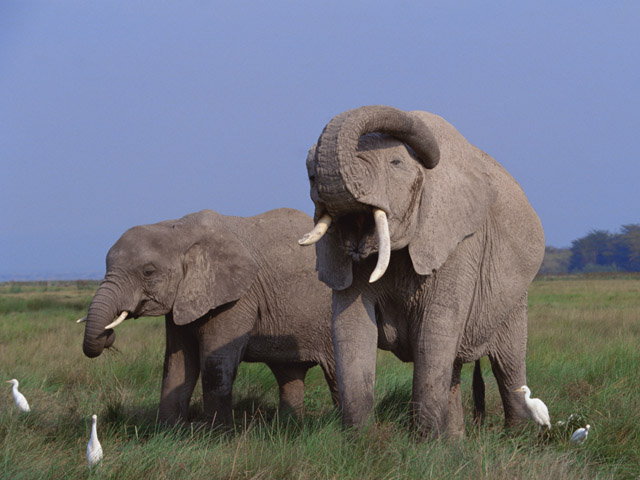
The elephants incredible trunk is actually an extended nose and upper lip.
The sense of smell is not compromised by the other tasks that the elephants nose is involved in, in fact It is believed that an elephants sense of smell is four times better than a bloodhounds!
At an average of 6 feet in length- sometimes as long as 7 feet- it is used effectively as an arm, and at its tip are finger-like extensions - two on the African elephants trunk and one on the Asian elephants trunk.
Called proboscides, these extensions are so delicate they can deliver a single blade of grass to the mouth. The trunk can reach over 20 feet high into trees for fruits or leaves or suck up and discharge up to 5 gallons of water at a time to bathe in, or playfully spray others with.
The trunk has no bones but it is layered with muscle and immensely powerful, weighing up to 350 pounds, and allowing the elephant to lift trees out of the ground or casually roll boulders out of its path. If something irritates the lining of the trunk the elephant can and will sneeze.... just like us...only a tad louder. -Amazing Elephant Facts
 elephant life
elephant lifeThe Elephants brain
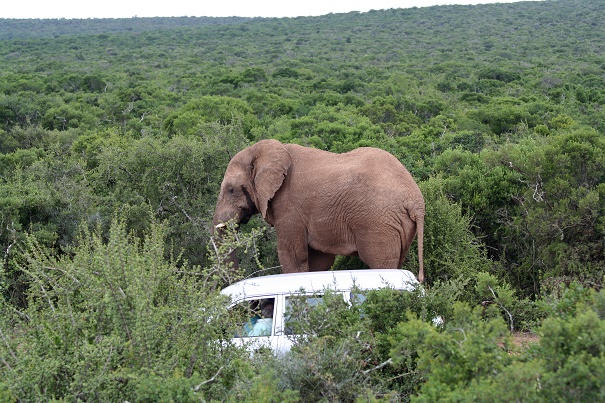
The brain of an elephant is naturally quite large, however it is still much smaller in relation to body size than our own. In terms of this ratio, known as the Encephalization quotient, elephants fall in the range of a chimpanzee.
However, the neocortex- the region of the brain devoted to cognitive process - or "reasoning" is greater in relative size than human beings and features highly developed regions of communication.
The trumpet of an elephant - such a recognizable sound - is not their only form of vocalization. Elephants have a vast vocabulary of grunts, whines and chirping sounds, as well as sounds of such a low decibel that human ears can't hear them.
The elephant also has an enormous number of neurons devoted to the mobility of the trunk, which is as dexterous as a human hand.
And finally, the area of the brain linked to emotions - the hippocampus- is larger in percentage than any other animal, including humans and whales.
the african elephant
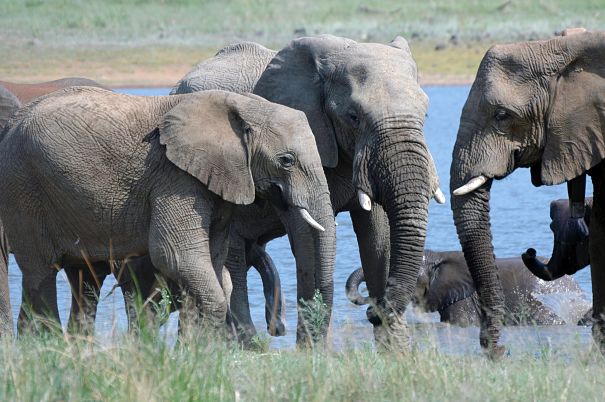 African elephants
African elephants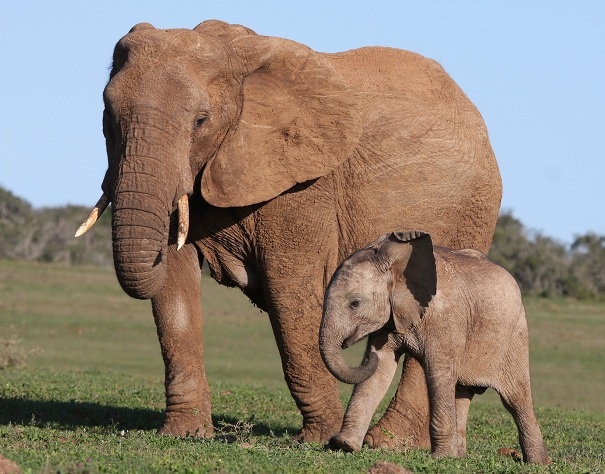 African elephant mother and baby
African elephant mother and babyThe largest animal on land, the African elephant starts out life big - usually 200 pounds at birth, and grows at a rate of up to 2 pounds a day. Most adult males reach full height - about 10 or 11 feet- at age fifteen, but continue to gain mass well into their thirties. As adults, these creatures have no natural enemies other than us.
The most critical issue facing African elephants is the slaughter for the use of their tusks. The tusks are modified teeth that begin to develop at about five months of age and grow continuously throughout the animals life.
Both male and female African elephants have tusks, but the males tend to be more massive and grow up to 8 inches a year. The ivory from tusks is used to make decorative items, and powdered elephant tusk is used as a medicinal aid and supplement.
In a fascinating twist of evolution, however, naturalists have begun to notice that some wild elephants are now reaching maturity without developing tusks at all. It seems the depletion of individuals with robust tusks has impacted the genepool. And the killing of elephants with large tusks before they are able to reproduce means tusk size has been going down for years, and in some cases tusk no longer form. Incredibly, the poachers may be saving the elephants without even knowing it.
Finally, a few words on the most famous African elephant of them all, whose name became a household word we still use almost everyday. In the late 1800's an African elephant named "Jumbo" - a variation of the Swahili word for "hello" - became a household name as he toured the world with P.T.Barnum and the "Greatest Show on Earth" the Barnum and Bailey circus.
He was about 13 feet tall and weighed approximately 15,000 pounds. In the circus he was billed as the largest elephant that ever lived and his name became synonymous with enormous size. Shockingly, he passed away after being hit by a train while waiting to be loaded into his railway car. His hide was mounted and stuffed and toured with the circus for many years after his death. It was eventually destroyed in a fire. Jumbos gigantic skeleton was mounted and donated to the American Museum of Natural History. - African Elephant Facts
the asian elephant
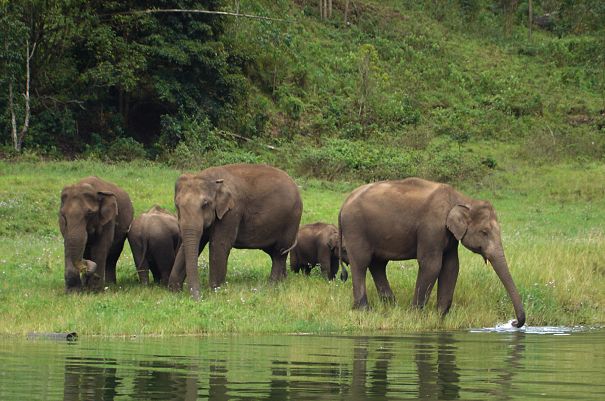 Wild Asian Elephants
Wild Asian Elephants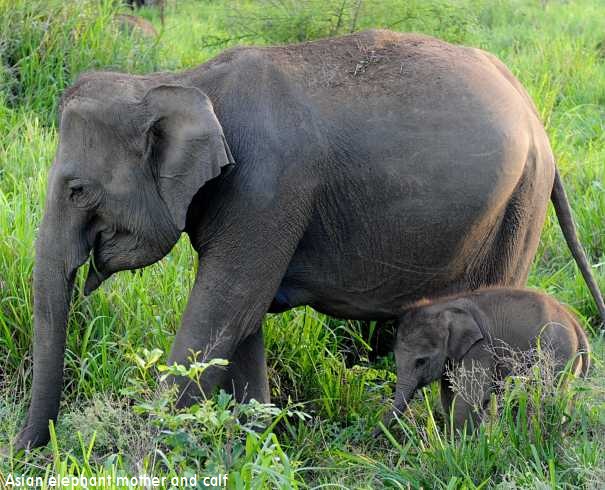 Asian Elephant mother and calf
Asian Elephant mother and calfThe Asian elephant, also known as the Indian elephant, has had a very long and rather unfortunate relationship with human beings.
They were first kept as beasts of burden about 5000 years ago in the area now known as Pakistan. Baby elephants were originally captured with the assumption that they would be easier to tame, but they would not survive in captivity without their mother.
Attempts to captively breed and domesticate elephants are futile because males in musth are exceedingly dangerous and must be kept in chains during this period. In addition, the length of the childhood of an elephant is unmanageable, with six to eight years devoted just to weaning
In modern day Asia, young adults between eight and twelve years old are captured and taken from their herds by a method called "mela shikar", where a captive trained elephant is used to help capture the wild one. Once imprisoned, the animals are trained by handlers called "mahouts", who may stay with the animal for the length of its life.
Elephants are used for many tasks including general transportation, farming, forestry and construction, and fully trained elephants may know over 300 specific commands.
The manner in which they are handled and tamed is often aggressive and involves intimidation and the infliction of pain in order to gain their cooperation. A long steel hook called an ankusa is used to hook around the ear, and often elephants are prodded in their mouths and throats to get the desired results .
Elephants have been the focus of much scientific study. When the elephants brain is examined and the cerebral cortex in particular is observed, indications are that the Asian elephant may be the most intelligent animal on earth - second only to human beings! - Asian Elephant Facts
reaching out - elephant conservation
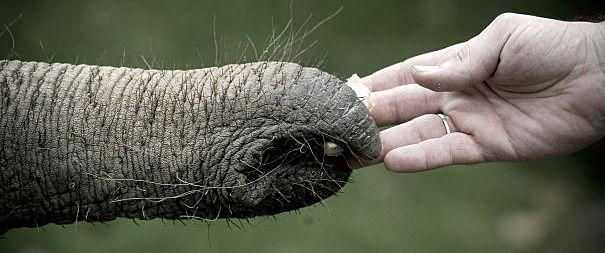
African elephants and Asian elephants are some of the most intelligent beings on Earth with a childhood, lifespan, social structure and understanding of life, death and self similar to our own.
They should be cherished and protected by us.
Their territories and range should be preserved to the best of our abilities.
And most importantly they should not be captured and removed from their families, and their use in circus acts and carnivals and as beasts of burden should be stopped to preserve not just their dignity but our own.
a few more elephant facts
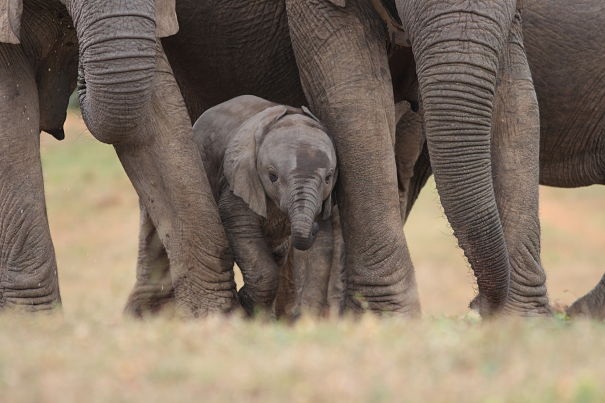
- The Asian elephant is often commonly referred to as the Indian elephant
- Wild African and Asian elephants reaching adulthood without ever growing tusks is becoming more common - an amazing evolutionary result of adults with large, well-formed tusks being killed off for their ivory before they can reproduce.- a very recent elephant fact and a fascinating example of micro-evolution!
- The Asian elephant has much smaller ears than the African elephant and has two distinctive bumps on thetop of the head.
- The largest bull African elephants can have 10 foot long tusks and must become accustomed to walking with their heads slightly raised lest they stop short jousting the ground - Elephant Facts
Scientific Classification:
| Elephant Facts - animalstats - | |||
|---|---|---|---|
| MALE | FEMALE | YOUNG | SOCIAL UNIT |
| bull | cow | calf | herd |
| HOME | HABITAT | LIFESPAN | FAVORITE FOOD |
| Africa, Asia | savanna,
forest, grasslands |
60-80 years | grass, leaves, fruit, roots, bark |
| AFRICAN ELEPHANT - population in wild - 500,000 | |||
| TRUNK | AVG. HEIGHT | AVG. LENGTH | AVG. WEIGHT |
| 5-7ft 350lbs | 7
- 13 feet at shoulder |
12 - 22 feet | 5,000 - 15,000lbs |
| ASIAN ELEPHANT - population in wild - 30,000 | |||
| TRUNK | AVG. HEIGHT | AVG. LENGTH | AVG. WEIGHT |
| 5-6ft 300lbs | 6 -
11 feet
at shoulder |
10 - 20 feet | 4,500 - 12,000lbs |
| TOP SPEED | GESTATION | BIRTHWEIGHT | AT BIRTH: |
| 22 mph | 22 months | 180-220 lbs | sighted,coarse hair |
| RAISED BY | # OF YOUNG | EYES OPEN | BABY STANDS |
| herd | 1, rarely 2 | at birth | 1.5 - 2 hours |
| WEANED | INDEPENDENT | MATURITY | ENDANGERED? |
| 2-4 years | 6 - 8 years | 16-20 years | vulnerable |
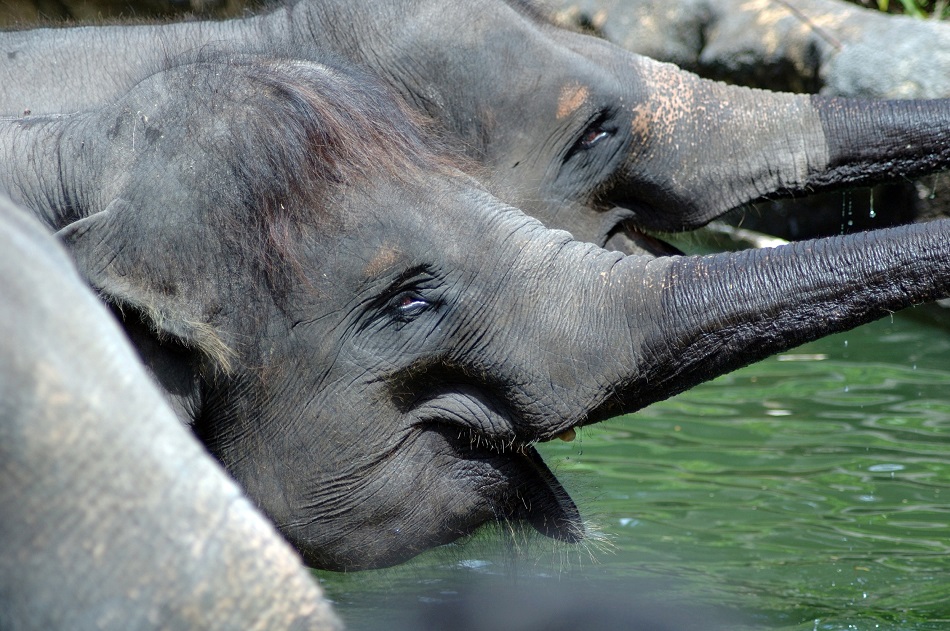 Hairy Young Asian Elephants
Hairy Young Asian Elephantssee more animal extreme closeups
Recent Articles
-
African Animals - Animal Facts Encyclopedia
Oct 11, 16 10:27 PM
African Animals facts photos and videos..Africa is a wonderland for animal lovers, and a schoolroom for anyone who wants to learn about nature, beauty and the rhythm of life -
Baboon Facts - Animal Facts Encyclopedia
Oct 11, 16 10:26 PM
Baboon facts, photos, videos and information - Baboons are very distinctive looking monkeys with long, dog-like snouts and close set eyes. -
Great Apes Facts - Animal Facts Encyclopedia
Oct 11, 16 10:25 PM
Great apes facts, photos and videos..Human beings did not evolve from chimpanzees, modern chimps and gorillas do not appear in the fossil records until much more recently than homo sapiens..
